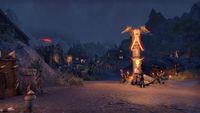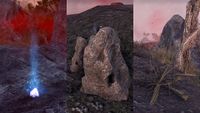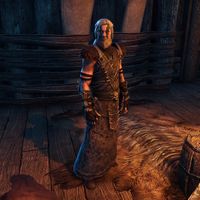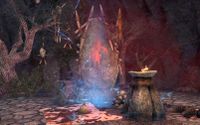Lore:Crow-Eye Clan
The Crow-Eye Clan was a clan of Reachfolk that lived in the Reach, a region in western Skyrim during the Interregnum in Second Era. They were a settled clan, and as of 2E 582 they inhabited the village of Karthwasten.[1][2] Their patron spirit was Nocturnal.[3][4]
History[edit]
Little is known of Crow-Eye Clan's origins, but the area where Karthwasten was located was historically the site of continuous conflict between Reachmen and the Nords of Western Skyrim, with the territory around Karthwasten, in particular, changing hands multiple times through the Eras.[5][6][7] Numerous stories of woe and treachery were told about the settlement over the years. The most prominent one was The Seeping Sickness of Karthwasten.[6]
By the mid-500s of the Second Era, the aforementioned conflict had reached a stalemate. Although the Nords had successfully seized control of the territory north of Karthwasten, Karthwasten itself was the territory of the Crow-Eye Clan, led by its spiritual leader Shaman Ulvoch.[5][3] During the time of Nordic occupation Sanuarach Mine was opened near to the village to exploit the land, but once Reachfolk reclaimed the land from Nordic colonizers it was abandoned.[3][8]
At some point before 2E 558, during the reign of the Longhouse Emperors the village was visited by Camhain Tharn and described in his A Reach Travel Guide. As of that time, the local clan was willing to trade with outsiders, accepting both empire's gold and goods for barter.[9]
In 2E 582, the Icereach Coven began performing Harrowstorm rituals throughout Western Skryim and the Reach; stealing the souls of its residents to resurrect the Gray Host. Crow-Eyes of Karthwasten were one of their targets. The settlement survived, largely thanks to the defensive wards the Crow-Eye Clan maintained, but numerous members of the clan were still affected by the harrowstorms and turned into harrowed. Although the wards stopped the worst of the storm, they were damaged and required restoration.[3][2]
In the same year, the village was visited by an outsider who was willing to aid locals with their problems related to the Gray Host activity in the region. Ulvoch, the local shaman accepted their help and requested them to help Fialyn, his apprentice with the renewal of the wards. They collected materials with a connection to Karthwasten and the surrounding countryside and offered them to the spirits. However, the final part of the ritual was disturbed by the Netherroot, a plant that was cultivated by the Gray Host in the Sanuarach Mine. After the mines were cleared, and Grey Host defeated the ritual was finished successfully and the wards have been restored.[3][2][10] Damaged buildings were not restored, however, as they were seen as "echoes left over from those who did not belong".[4]
Crow-Eye Clan thrived once again and the outsider was named a Crow-Eye in spirit and a friend to the Clan.[3][11][2] Shaman Ulvoch attended the moot during which regional leaders Ard Caddach of the Reach, and Jarl Svana and King Jorunn of Skyrim signed the peace treaty between the Reach, Eastern Skyrim, and Western Skyrim.[12]
As of 4E 201 the village of Karthwasten was led by a Reachfolk man known as Ainethach. His family owned Karthwasten for generations. It is unknown, however, if they descended from the Crow-Eye Clan or acquired the village through another means.[13]
Culture[edit]
Reachfolk of the Crow-Eye clan did not revere the spirits. Their relationship with them relied on negotiation and "giving and receiving what is expected". Although they primarily looked to the Nocturnal for guidance, their wards also honored other spirits such as Hircine, Namira and Molag Bal. Although they recognized the dangers of the Daedra, they believed that they cannot be judged by mortal standards. Instead, they sought to bargain with them, appease them, and use whatever blessings they provide.[4][3] They a different relationship with each spirit. Some were asked for guidance, others provided protection. Nocturnal was seen as the spirit of the night and was asked to send her crows to guard the clan. Hircine, as the spirit of the hunt, was asked for a plentiful bounty. Namira was associated with the ancient darkness and invoked to protect the souls of the mortals. Lastly, Molag Bal, the spirit of torment and trouble, was seen as a testing deity and a harsh teacher. Crow-Eyes asked him to teach them how to endure the struggle.[3]
Part of their relationship with the spirits manifested in the protective wards, which required renewal and offerings. In order to maintain it they were bringing offerings of nature and earth to each of the wards and spirits associated with them. Each offering represented different elements of life.[4] Each offering had a different significance to each spirit. The most important aspect was that these materials had a connection to Karthwasten and the surrounding countryside. The offerings were meant to remind members of the clan of the bond they shared with the land. [3] The fallen branches of willow trees, represented the fragility of life.[4][14] Rocks bathed in moonlight stood for purity.[4][15] Husks of the cicada represented rebirth.[4][16]
—Gorrof[17]
Members of the Crow-Eye Clan were deeply connected to nature and the land.[4] They believed that "dark things tend to happen when the land is angry". According to them the land provides, and everything it provides, it expects payment for. Whenever one uses something, one must give something in return. This belief extended beyond the relationship with the nature itself, and also applied to their dealings with the Great Spirits. It lacked clearly definied rules, but was ultimately fairly simple- paying respect to land and spirits could take the form of anything from a whisper of thanks to returning seeds to the dirt.[18] They believed that magic sleeps in the stones underground, but refused to break them. They believed that their place was to listen to the song of the earth and the beating of the heart.[19]
Similarly to many other Reachfolk clans they believed that life is meant to be a struggle,[20] and that dirt and harsh and unforgiving nature of the world is part of life. The real discipline comes from enduring the struggle,[17] and from hard work. They respect those who perform hard labor and look down on cultures that treat their workers poorly and without appropriate respect.[21] They spend their lives fighting for what is theirs, clawing for survival.[22] Crow-Eyes were known to accept clanless individuals, formerly of other clans into their ranks.[17] They were affiliated neither with Ard Caddach nor with Arana's Wayward Guardians, with members of the clan questioning the validity of the rebellion,[23] and expressing the belief that while both Arana and Caddach have answers, and try to solve the same problem, the village of Karthwasten have its own troubles, that are not addressed by either of the factions.[20]
The Shaman of the clan was responsible for every ritual and clan ceremony and for keeping the sacred rites and traditions. They were typically assisted by their apprentice. A shaman usually selected their apprentice, but occasionally a willing candidate petitioned the shaman themselves to become their pupil instead. Maintaining the wards was one of the duties of the shamans and their apprentices.[4][3]
When Karthwasten was inhabited by the Crow-Eye Clan, the village was known for its domesticated Silver Boars.[24] Occasionally, friends and honor-kin of the clan were bestowed with powerful bows, symbolizing their special status.[25]
See Also[edit]
- For game-specific information, see the Elder Scrolls Online
 article.
article.
References[edit]
- ^ Karthwasten in ESO
- ^ a b c d Events of After the Storm in ESO
- ^ a b c d e f g h i j Apprentice Fialyn's dialogue in ESO
- ^ a b c d e f g h i Shaman Ulvoch's dialogue in ESO
- ^ a b Guide to Western Skyrim: Karthald — Imperial Surveyor Buntara Gravius
- ^ a b Scary Tales of the Druadach, Book 2 — Cassia Volcatia, Traveling Scribe
- ^ Falkfyr's Notes, Page 1 — Scout Falkfyr
- ^ Nord Child's Journal
- ^ A Reach Travel Guide — Camhain Tharn
- ^ Malformed Root, Misshapen Tendril and Horrid Vine descriptions in ESO
- ^ Shaman Ulvoch's dialogue in ESO
- ^ Events of Second Chances in ESO
- ^ Ainethach's dialogue in Skyrim
- ^ Willow Branch's description in ESO
- ^ Moon-Touched Stones's description in ESO
- ^ Cicada Husk's description in ESO
- ^ a b c Gorrof's dialogue in ESO
- ^ Arllonal's dialogue in ESO
- ^ Sanuarach Mine in ESO
- ^ a b Cantillikh's dialogue in ESO
- ^ Hereline's dialogue in ESO
- ^ Eamon's dialogue in ESO
- ^ Aeodfaern's dialogue in ESO
- ^ Karthwasten Silver Boar's description in ESO
- ^ Crow-Eye's Striker in ESO: Markarth




